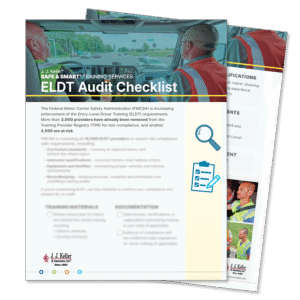In this series, we look at the steps and missteps involved in obtaining and maintaining your CDL.
Well, you’ve jumped the first set of hurdles, and you have your commercial learner’s permit (CLP). At this point, you can practice driving — provided you have someone riding shotgun who already has their commercial driver’s license (CDL) in hand.
Pay attention to what that person tells you; let them show you what they’ve learned about navigating the road. Soak in what they do well … but don’t ignore their mistakes. Everyone has made a few from time to time. Any trainer worth their salt will own up to the ones they’ve made. There’s plenty to be learned, both good and bad, from every person you have the opportunity to train with.
You can learn all the tricks of the trade from any long-time CDL holder, but as of Feb. 7, 2022, the Federal Motor Carrier Safety Administration (FMCSA) has specific training requirements. Anyone who wants to get a new Class A or B license, or upgrade a license from Class B to Class A, must successfully complete the FMCSA’s Entry Level Driver Training (ELDT). The same holds true if you’re applying for a hazardous materials (hazmat) endorsement for the first time.
So, you ask, what is ELDT?
Essentially, ELDT is part of the same process would-be commercial drivers went through to earn a CDL before the term was created and mandated. When the FMSCA unveiled the ELDT requirements, it estimated that 85% of entry-level drivers already had gone through ELDT-approved training.
The primary difference in CDL training before and after Feb. 7, 2022, was the curriculum. Before that date, curriculum for various training programs might have varied to some extent. The new law mandates the same curriculum be used for every driver training program. So, most driver training programs that existed before ELDT became effective still exist today. In fact, the FMSCA even has a handy Training Provider Registry to help you find a trainer that’s just right for your situation.
Now, when it comes to selecting a driver training program, options exist on almost every corner.
Some carriers offer programs as part of their driver recruitment programs. Community colleges, independent school districts, private training companies, rural cooperatives and some state workforce programs also provide ELDT-approved training for commercial drivers. If you want to earn your CDL, check out the Training Provider Registry. Chances are, there’s a program near you.
As you train, you’ll study a combination of book knowledge (“theory”). You’ll also have lots of opportunities for “in-the-cab” training. Once you meet the minimum requirements of both (check your state’s requirements), you’ll be ready for testing. Testing is divided into two parts, written and skills.
Assuming you’ve been paying attention in class, practiced your driving skills on the road and passed the necessary background checks, you could be holding your CDL on your first try!
If you fail the first (or even the second) time, however, don’t get discouraged. Maybe you need to study harder or practice certain skills a little more. Put your heart and soul into your chosen career, and you’ll make it through.
Once you have that CDL in hand, you’ll be ready for the road. One thing is guaranteed: You will never stop learning.
To find truck driving schools in your area, click here.
Check back next week for the next installment in The Trucker’s “So, you want to be a truck driver” series.
Since retiring from a career as an outdoor recreation professional from the State of Arkansas, Kris Rutherford has worked as a freelance writer and, with his wife, owns and publishes a small Northeast Texas newspaper, The Roxton Progress. Kris has worked as a ghostwriter and editor and has authored seven books of his own. He became interested in the trucking industry as a child in the 1970s when his family traveled the interstates twice a year between their home in Maine and their native Texas. He has been a classic country music enthusiast since the age of nine when he developed a special interest in trucking songs.














